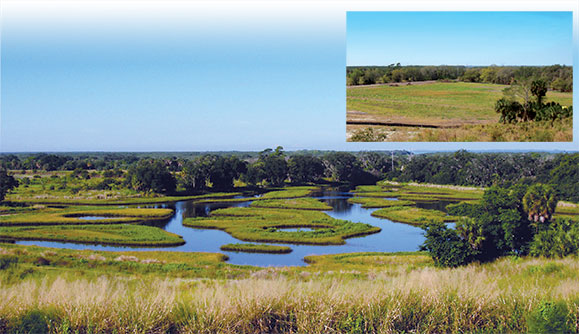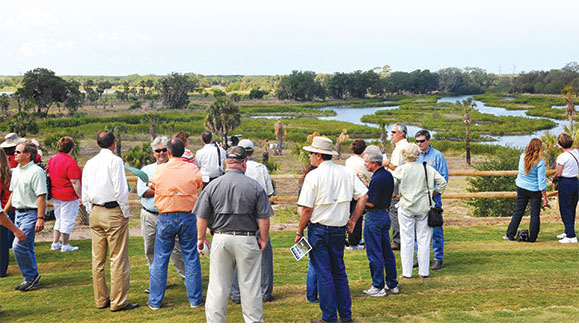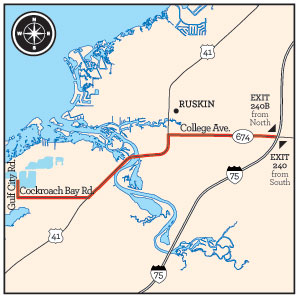
Cockroach Bay before and after (top right) restoration.
Gazing from atop the crest of “Mount Cockroach,” visitors were treated to the views of lush wetlands, uplands and coastal habitats of Cockroach Bay.
They saw birds and other wildlife freely roam through the flourishing vegetation that surrounded the calm waters.
But the distant view of city skyscrapers in Tampa and St. Petersburg served as a reminder of the urban activities that once threatened the land and why it took the effort of so many to restore it.
The District, along with Hillsborough County and the Tampa Port Authority, recently held a dedication ceremony for the Cockroach Bay Restoration Project. Executive Director Blake Guillory kicked off the ceremony by explaining Cockroach Bay was one of the largest, most complex coastal ecosystem restoration projects ever developed for Tampa Bay.
“This project is a magnificent achievement for the Tampa Bay region,” Guillory said. “It’s recognized internationally as the way to do habitat restoration. Its success is due to 20 years of hard work and collaboration between many team members.”
About 100 people attended the dedication ceremony, including several political and community leaders. Speakers applauded the teamwork of agencies and marveled at the finished product.

“This is a community treasure and all of you played a significant role,” said U.S. Rep. Kathy Castor, who recalled visiting the area as a child.
Before the restoration, Cockroach Bay suffered from a number of environmental problems including habitat degradation, invasive plant infestation and poor water quality.
“This project is special not only from the level of cooperation and number of partners, but also due to its size and complexity — 500 acres of coastal restoration inclusive of 282 acres of various estuarine and freshwater habitats and 218 acres of various coastal uplands,” said Brandt Henningsen, the District’s chief environmental scientist.
The restoration was completed in 17 phases through the past 20 years as a pay-as-you go project. In 1991, Hillsborough County purchased the 651-acre property located just outside the Alafia River watershed boundary in southwest Hillsborough County. The land was largely agricultural fields and shell mining pits near the bay.
The project was initiated by the District’s Surface Water Improvement and Management (SWIM) Program and the Hillsborough County Parks, Recreation and Conservation Department. It took the help of 26 groups and government agencies, plus the collaboration of many teams within the District.
“The District prides itself on its teamwork and ability to work with other groups,” said Hugh Gramling, vice chair of the District’s Governing Board.
SWIM staff members helped plan, design, implement and manage the project including helping to secure permits and funding. The Data Collection team surveyed the land to provide baseline data needed to begin the work on the wetland phases. Staff in the Operations, Maintenance and Construction Division constructed five of the wetland phases of the project. District Board members were key in supporting the project and approving funding.
Gramling also thanked the more than 2,500 volunteers who helped plant trees and wetland grasses through the years at the Cockroach Bay site.
“I don’t think it would have been affordable to do without that help,” Gramling said.
As part of the restoration project, garbage was removed while other recycled materials were brought in. About 176 tons of garbage were hauled away from the 500‑acre restoration site during the course of the project. And 500,000 cubic yards of recycled dredged material were used to restore a portion of the mining pits.
The final phase of the project included restoring two shell pits funded by the Tampa Port Authority. The dedication ceremony concluded with the release of four rehabilitated brown pelicans from the Suncoast Seabird Sanctuary.
The creatures swooped across their new home. The picturesque property will not only provide a safe place for wildlife and recreation for residents, it will filter pollutants and create a cleaner Tampa Bay.

If You Go:
Cockroach Bay 3709 Gulf City Road, Ruskin Open: sunrise to sunset, Monday–Thursday
